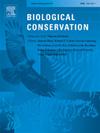Addressing the urgent climate and biodiversity crisis through strategic ecosystem restoration in Brazil
IF 4.9
1区 环境科学与生态学
Q1 BIODIVERSITY CONSERVATION
引用次数: 0
Abstract
Ecosystem restoration is crucial worldwide to address environmental challenges. Many countries, including Brazil, have committed to restoring degraded landscapes at national and international levels. Brazil aims to restore twelve million hectares of degraded areas by 2030, which requires strategic decision-making to allocate resources effectively and balance biodiversity gains with societal benefits. Our modeling approach uses extensive biodiversity field data to identify priority areas for restoration across Brazil's diverse phytogeographic domains. By focusing on expanding native species habitats and enhancing connectivity, we aim to maximize ecological returns. Precisely, we pinpoint areas within each Brazilian phytogeographic domain with the greatest potential for habitat enhancement, including the Amazon's arc of deforestation, central Cerrado, the limits of Caatinga, Pampa, and Pantanal, and the coastal areas of the Atlantic Forest. Restoring 30 % of these areas—approximately 76 million hectares—could significantly benefit 11,028 species by increasing available habitat by up to 10 % and improving landscape functional connectivity by 60 %. Moreover, this restoration effort would capture up to 9.8 million tons of atmospheric carbon, contributing to global climate goals. As Brazil strives to meet national and international targets, we also advocate for economic incentives to support restoration practices within each phytogeographic domain. Integrating prioritization modeling into decision-making ensures optimal biodiversity and carbon stock outcomes to guide more effective restoration efforts. This comprehensive strategy helps advance restoration goals and underscores the vital role of science-based planning in safeguarding our planet's natural heritage.
求助全文
约1分钟内获得全文
求助全文
来源期刊

Biological Conservation
环境科学-环境科学
CiteScore
10.20
自引率
3.40%
发文量
295
审稿时长
61 days
期刊介绍:
Biological Conservation is an international leading journal in the discipline of conservation biology. The journal publishes articles spanning a diverse range of fields that contribute to the biological, sociological, and economic dimensions of conservation and natural resource management. The primary aim of Biological Conservation is the publication of high-quality papers that advance the science and practice of conservation, or which demonstrate the application of conservation principles for natural resource management and policy. Therefore it will be of interest to a broad international readership.
 求助内容:
求助内容: 应助结果提醒方式:
应助结果提醒方式:


